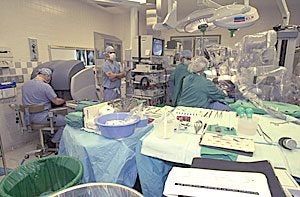ECU team completes 100th robot-assisted mitral valve surgery
Dr. W. Randolph Chitwood and his surgical team have performed their 100th robotic cardiac mitral valve repair using the da Vinci Surgical System–a milestone for robotic surgical technology and minimally invasive cardiac surgery.
The patient, a 46-year-old emergency medicine physician from the Charlotte area, Dr. Robert Petrilli, did well during the Monday surgery and is recuperating comfortably today, Chitwood said. Petrilli suffered from severe mitral valve regurgitation and prolapse, defects that Chitwood was able to repair using the surgical robot.

Dr. Randolph Chitwood, far left, performs surgery from the da Vinci Surgical System console during the 100th mitral valve surgery using the da Vinci Surgical System at Pitt County Memorial Hospital. For more photos, click here. Photo by Cliff Hollis
Chitwood is professor of surgery, chief of cardiothoracic and vascular surgery, and senior associate vice chancellor for health sciences at the Brody School of Medicine at East Carolina University. The operation was performed at Pitt County Memorial Hospital, the affiliated teaching hospital for ECU’s medical school.
In May 2000, Chitwood performed the first total heart valve surgery using robotic technology in North America. Since then, he has taught more than 150 heart surgeons from around the world how to use the da Vinci for cardiac and mitral valve surgery through the Minimally Invasive Surgical Training Center at ECU.
Data compiled by Dr. Wiley Nifong, director of surgical robotics at the Brody School of Medicine, shows that time on the heart-lung machine has decreased by 30 minutes in those 100 procedures. Furthermore, length of stay in the hospital is less than four days compared to eight days for conventional open-heart procedures. Most patients are back to work in 10 to 14 days.
Each year, more than 50,000 procedures are performed on the mitral valve, which regulates the blood flow from the left atrium, or holding chamber, to the left ventricle, the heart’s main pumping chamber.
“During these first 100 operations, we have learned that cardiac surgery can be done safely using robotic techniques with the same results as a full sternotomy (full chest incision). Visualization and dexterity are much better,” Chitwood said. “There is a learning phase and during that time operations take longer but have similar results. However, after this early period surgeons with some experience in endoscopy easily adapt to this advancement in technology.
“The early adopters are becoming more convinced of the efficacy of mitral valve surgery done robotically. Now the more traditional majority has become interested and we have trained more than 50 surgical teams in these methods. This 100th case signifies that surgeons and staff at our institution and those trained by us now have full confidence in these robotic assistants in surgery and that they are safe and effective.”
With the da Vinci Surgical System, Chitwood and his colleagues make three dime-sized incisions in the chest, through which they insert three robotic arms. One arm holds a tiny camera that projects three-dimensional images onto a monitor in front of the surgeon; the other two arms hold the pencil-sized instruments, which have tiny computerized mechanical “wrist” instrument tips designed to transmit the dexterity of the surgeon’s forearm, wrist and fingers into the chest at the operative site.
Seated at a computer console a few feet away from the operating table, the surgeon views a magnified, three-dimensional image and manipulates the surgical instruments using two fingertip controls.
Chitwood has also used the da Vinci Surgical System in his treatment of atrial fibrillation in patients who also have defective mitral valves. In atrial fibrillation the heart’s two upper chambers, the atria, quiver instead of beating effectively.